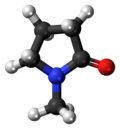N-Methyl-2-pyrrolidone
| |||
| Names | |||
|---|---|---|---|
| Preferred IUPAC name 1-Methylpyrrolidin-2-one | |||
| Other names 1-Methyl-2-pyrrolidone N-Methylpyrrolidone N-Methylpyrrolidinone Pharmasolve | |||
| Identifiers | |||
CAS Number |
| ||
3D model (JSmol) |
| ||
| ChEBI |
| ||
| ChEMBL |
| ||
| ChemSpider |
| ||
| ECHA InfoCard | 100.011.662 | ||
| KEGG |
| ||
PubChem CID |
| ||
| UNII |
| ||
CompTox Dashboard (EPA) |
| ||
InChI
| |||
| |||
| Properties | |||
Chemical formula | C5H9NO | ||
| Molar mass | 99.133 g·mol−1 | ||
| Density | 1.028 g/cm3 | ||
| Melting point | −24 °C (−11 °F; 249 K) | ||
| Boiling point | 202 to 204 °C (396 to 399 °F; 475 to 477 K) | ||
Solubility in water | Soluble[1] | ||
| Solubility in Ethanol, acetone, diethylether, ethyl acetate, chloroform, benzene | Soluble[1] | ||
| log P | −0.40[2] | ||
| Hazards | |||
| NFPA 704 (fire diamond) |  2 2 1 | ||
Except where otherwise noted, data are given for materials in their standard state (at 25 °C [77 °F], 100 kPa).  N verify (what is N verify (what is  Y Y N ?) N ?) Infobox references | |||
N-Methyl-2-pyrrolidone (NMP) is an organic compound consisting of a 5-membered lactam. It is a colorless liquid, although impure samples can appear yellow. It is miscible with water and with most common organic solvents. It also belongs to the class of dipolar aprotic solvents such as dimethylformamide and dimethyl sulfoxide. It is used in the petrochemical, polymer and battery industries as a solvent, exploiting its nonvolatility and ability to dissolve diverse materials (including polyvinylidene difluoride, PVDF).[3]
Preparation
NMP is produced industrially by a typical ester-to-amide conversion, by treating gamma-butyrolactone with methylamine. Alternative routes include the partial hydrogenation of N-methylsuccinimide and the reaction of acrylonitrile with methylamine followed by hydrolysis. About 200,000 to 250,000 tons are produced annually.[3]
Applications
NMP is used to recover certain hydrocarbons generated in the processing of petrochemicals, such as the recovery of 1,3-butadiene and acetylene. It is used to absorb hydrogen sulfide from sour gas and hydrodesulfurization facilities. Its good solvency properties have led to NMP's use to dissolve a wide range of polymers. Specifically, it is used as a solvent for surface treatment of textiles, resins, and metal coated plastics or as a paint stripper. It is also used as a solvent in the commercial preparation of polyphenylene sulfide. In the pharmaceutical industry, N-methyl-2-pyrrolidone is used in the formulation for drugs by both oral and transdermal delivery routes.[4] It is also used heavily in lithium ion battery fabrication, as a solvent for electrode preparation, because NMP has a unique ability to dissolve polyvinylidene fluoride binder. Due to NMP's toxicity and high boiling point, there is much effort to replace it in battery manufacturing with other solvent(s), like water.[5][6]
Safety
N-Methyl-2-pyrrolidone is a relatively innocuous compound with an LD50 of 4150 mg/kg (oral, rats).[7] It is non-mutagenic[3]
See also
References
- ^ a b Sigma-Aldrich Co., 1-Methyl-2-pyrrolidinone. Retrieved on 22 March 2022.
- ^ "N-Methylpyrrolidone_msds".
- ^ a b c Harreus, Albrecht Ludwig; Backes, R.; Eichler, J.-O.; Feuerhake, R.; Jäkel, C.; Mahn, U.; Pinkos, R.; Vogelsang"2-Pyrrolidone, R. (2011). Ullmann's Encyclopedia of Industrial Chemistry. Weinheim: Wiley-VCH. doi:10.1002/14356007.a22_457.pub2. ISBN 978-3527306732.
{{cite encyclopedia}}: CS1 maint: numeric names: authors list (link) - ^ "Pharmasolve® Drug Solubilizer" (PDF). PharmaGuide. International Specialty Products, a division of Ashland Inc.: Page 9. Retrieved 2012-06-06.
- ^ "Production of batteries made cheaper and safer, thanks to Finnish researchers". Science Daily. Retrieved 7 May 2015.
- ^ Wu, F., Liu, M., Li, Y. et al. High-Mass-Loading Electrodes for Advanced Secondary Batteries and Supercapacitors. Electrochem. Energ. Rev. 4, 382–446 (2021). https://doi.org/10.1007/s41918-020-00093-0
- ^ "Safety Data Sheet". 2024-03-06. Retrieved 2024-07-31.












